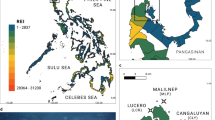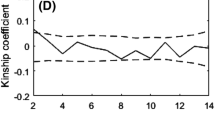Abstract
The interpretation of genetic variation on and among corals on reefs has rarely been contextualized in an explicitly spatial framework where each individual has both genetic and spatial parameters. Here, we explore interactions between sampling effort, sampling design, and the presence of spatial genetic structure (SGS) on the ability to effectively characterize genetic diversity on a coral reef. To do this, we take our dataset of 2352 genotypes (78 unique multi-locus genotypes) of the coral, Pocillopora damicornis, collected from June 2007 to October 2009, a dataset of near-exhaustive sampling of a single patch reef in Kāne‘ohe Bay, Hawai‘i (21°27.462N, 157°48.405W), and subsample from it using three different strategies: (1) random sampling from throughout the reef; (2) saturation sampling all corals from within a pre-defined area of the reef, avoiding the reef’s edge; and (3) sampling all nearest neighbors of a randomly chosen coral while allowing for the inclusion of the reef’s edge. Our results demonstrate appreciable variation (e.g., 0.35–0.46) in estimates of observed heterozygosity (H O) using a typical sample size of 50 and that in the presence of SGS, non-random sampling schemes can give biased estimates of genetic diversity. Furthermore, our results indicate that over 1000 samples (i.e., ~40 % of the total number of colonies) are required to reveal the true pattern of spatial genetic structure at our site. We also demonstrate by rarefaction analysis that the bias in estimating clonal richness (i.e., the proportion of unique genotypes in a given sampling area relative to the total number of samples surveyed) for small sample numbers is due to the predominance of clones (i.e., high level of clonality) and not skew in genet frequency distribution. Overall, we argue that: (1) consideration of sampling design is important in population genetic studies, particularly since non-random sampling in the presence of SGS can give biased estimates of genetic diversity and (2) intense to near-exhaustive sampling schemes may be important for characterizing genetic diversity in highly clonal populations.







Similar content being viewed by others
References
Alberto F, Gouveia L, Arnaud-Haond S, Pérez-Lloréns JL, Duarte CM, Serrão EA (2005) Within-population spatial genetic structure, neighbourhood size and clonal subrange in the seagrass Cymodocea nodosa. Mol Ecol 14:2669–2681
Arnaud-Haond S, Duarte CM, Alberto F, Serrão EA (2007) Standardizing methods to address clonality in population studies. Mol Ecol 16:5115–5139
Arnaud-Haond S, Vonau V, Rouxel C, Bonhomme F, Prou J, Goyard E, Boudry P (2008) Genetic structure at different spatial scales in the pearl oyster (Pinctada margaritifera cumingii) in French Polynesian lagoons: beware of sampling strategy and genetic patchiness. Mar Biol 155:147–157
Baltanás A (1992) On the use of some methods for the estimation of species richness. Oikos 65:484–492
Baums IB, Miller MW, Hellberg ME (2006) Geographic variation in clonal structure in a reef-building Caribbean coral, Acropora palmate. Ecol Mono 76:503–519
Becheler R, Diekmann O, Hily C, Moalic Y, Arnaud-Haond S (2010) The concept of population in clonal organisms: mosaics of temporally colonized patches are forming highly diverse meadows of Zostera marina in Brittany. Mol Ecol 19:2394–2407
Becheler R, Benkara E, Moalic Y, Arnaud-Haond S (2013) Scaling of processes shaping the clonal dynamics and genetic mosaics of seagrasses through temporal genetic monitoring. Hered 112:114–121
Billingham MR, Simões T, Reusch TBH, Serrão EA (2007) Genetic sub-structure and intermediate optimal outcrossing distance in the marine angiosperm Zostera marina. Mar Biol 152:793–801
Björklund M, Bergek S (2009) On the relationship between population differentiation and sampling effort: is more always better? Oikos 118:1127–1129
Blanquer A, Uriz M, Caujapé-Castells J (2009) Small-scale spatial genetic structure in Scopalina lophyropoda, an encrusting sponge with philopatric larval dispersal and frequent fission and fusion events. Mar Ecol Prog Ser 380:95–102
Brose U, Martinez ND, Williams RJ (2003) Estimating species richness: sensitivity to sample coverage and insensitivity to spatial patterns. Ecol 84:2364–2377
Calderón I, Ortega N, Duran S et al (2007) Finding the relevant scale: clonality and genetic structure in a marine invertebrate (Crambe crambe, Porifera). Mol Ecol 16:1799–1810
Cavers S, Degen B, Caron H, Lemes MR, Margis R, Salgueiro F, Lowe AJ (2005) Optimal sampling strategy for estimation of spatial genetic structure in tree populations. Hered 95:281–289
Chao A, Shen T-J (2003) Nonparametric estimation of Shannon’s index of diversity when there are unseen species in sample. Enviro Ecol Stat 10:429–443
Combosch DJ, Vollmer SV (2011) Population genetics of an ecosystem-defining reef coral Pocillopora damicornis in the tropical eastern Pacific. PLoS ONE 6:e21200
De Meeûs T, Lehmann L, Balloux F (2006) Molecular epidemiology of clonal diploids: a quick overview and a short DIY (do it yourself) notice. Infect Genet Evol 6:163–170
Ellstrand NC, Roose ML (1987) Patterns of genotypic diversity in clonal plant species. Am J Bot 74:123–131
Epperson BK (1993) Spatial and space-time correlations in systems of subpopulations with genetic drift and migration. Genetics 133:711–727
Fager EW (1972) Diversity: a sampling study. Am Nat 106:293–310
Gorospe KD, Karl SA (2013) Genetic relatedness does not retain spatial pattern across multiple spatial scales: dispersal and colonization in the coral, Pocillopora damicornis. Mol Ecol 22:3721–3736
Halkett F, Simon J, Balloux F (2005) Tackling the population genetics of clonal and partially clonal organisms. TREE 20:194–201
Hardy OJ, Vekemans X (1999) Isolation by distance in a continuous population: reconciliation between spatial autocorrelation analysis and population genetics models. Hered 83:145–154
Hardy OJ, Vekemans X (2002) SPAGeDi: a versatile computer program to analyse spatial genetic structure at the individual or population levels. Mol Ecol Not 2:618–620
Heywood JS (1991) Spatial analysis of genetic variation in plant populations. Ann Revi Ecol Syst 22:335–355
Hunter CL (1993) Genotypic variation and clonal structure in coral populations with different disturbance histories. Evol 47:1213–1228
Johnson MS, Black R (1982) Chaotic genetic patchiness in an intertidal limpet, Siphonaria sp. Mar Biol 70:157–164
Jost L (2008) G ST and its relatives do not measure differentiation. Mol Ecol 17:4015–4026
Kalisz S, Nason JD, Hanzawa FM, Tonsor SJ (2001) Spatial population genetic structure in Trillium grandiflorum: the roles of dispersal, mating, history, and selection. Evol 55:1560–1568
Ledoux JB, Garrabou J, Bianchimani O, Drap P, Féral JP, Aurelle D (2010) Fine-scale genetic structure and inferences on population biology in the threatened Mediterranean red coral, Corallium rubrum. Mol Ecol 19:4204–4216
Legendre P, Dale MRT, Fortin M-J, Gurevitch J, Hohn M, Myers D (2002) The consequences of spatial structure for the design and analysis of ecological field surveys. Ecogr 25:601–615
McFadden CS (1997) Contributions of sexual and asexual reproduction to population structure in the clonal soft coral, Alcyonium rudyi. Evol 51:112–126
Meirmans PG (2012) The trouble with isolation by distance. Mol Ecol 21:2839–2846
Meirmans P, van Tienderen P (2004) GENOTYPE and GENODIVE: two programs for the analysis of genetic diversity of asexual organisms. Mol Ecol Not 4:792–794
Miller KJ, Ayre DJ (2008) Population structure is not a simple function of reproductive mode and larval type: insights from tropical corals. J Anim Eco 77:713–724
Moran PAP (1950) Notes on continuous stochastic phenomena. Biometrika 37:17–23
Nei M (1987) Molecular evolutionary genetics. Columbia University Press, New York
Palumbi SR (2003) Population genetics, demographic connectivity, and the design of marine reserves. Ecol Apps 13:S146–S158
Pauls SU, Nowak C, Bálint M, Pfenninger M (2013) The impact of global climate change on genetic diversity within populations and species. Mol Ecol 22:925–946
Pinheiro JC, Bates DM, DebRoy S, Sarkar D, The R Development Core Team (2013) NLME: linear and nonlinear mixed effects models. R package version 3.1-111
Polato N, Concepcion GT, Toonen RJ, Baums IB (2010) Isolation by distance across the Hawaiian Archipelago in the reef-building coral Porites lobata. Mol Ecol 19:4661–4677
Raymond M, Rousset F (1995) GENEPOP (version 1.2): population genetics software for exact tests and ecumenicism. J Hered 86:248–249
Riginos C, Douglas KE, Jin Y, Shanahan DF, Treml EA (2011) Effects of geography and life history traits on genetic differentiation in benthic marine fishes. Ecog 34:566–575
Rousset F (2008) GENEPOP’007: a complete re-implementation of the GENEPOP software for Windows and Linux. Mol Ecol Res 8:103–106
Ruzzante D (1998) A comparison of several measures of genetic distance and population structure with microsatellite data: bias and sampling variance. Can J Fish Aquat Sci 55:1–14
Schwartz MK, McKelvey KS (2008) Why sampling scheme matters: the effect of sampling scheme on landscape genetic results. Con Gen 10:441–452
Selkoe KA, Watson JR, White C, Horin B, Iacchei M, Mitarai S, Siegel DA, Gaines SD, Toonen RJ (2010) Taking the chaos out of genetic patchiness: seascape genetics reveals ecological and oceanographic drivers of genetic patterns in three temperate reef species. Mol Ecol 19:3708–3726
Slatkin M, Arter HE (1991) Spatial autocorrelation methods in population genetics. Am Nat 138:499–517
Sokal RR, Oden NL, Thomson BA (1997) A simulation study of microevolutionary inferences by spatial autocorrelation analysis. Biol J Lin Soc 60:73–93
Underwood JN, Smith LD, van Oppen MJH, Gilmour JP (2007) Multiple scales of genetic connectivity in a brooding coral on isolated reefs following catastrophic bleaching. Mol Ecol 16:771–784
van Oppen MJH, Gates RD (2006) Conservation genetics and the resilience of reef- building corals. Mol Ecol 15:3863–3883
Vekemans X, Hardy OJ (2004) New insights from fine-scale spatial genetic structure analyses in plant populations. Mol Ecol 13:921–935
Weersing K, Toonen R (2009) Population genetics, larval dispersal, and connectivity in marine systems. Mar Ecol Prog Ser 393:1–12
Weir BS, Cockerham CC (1984) Estimating F-statistics for the analysis of population structure. Evol 38:1358–1370
Acknowledgments
We acknowledge K. Withy-Allen, P. Bool, T. Burgess, M. Castrence, S. Churchill, M. Coloma, C. Demyan, M. DeLisle, K. Duncan, L. Furuto, M. Gaither, M. Hagedorn, R. Haverkort, M. Hayatdavoodi, L. Hedouin, H. Hilmer, M. Iacchei, D. Jayewardene, R. Lambrix, D. Lin, R. Lindemann, M. Lurie, B. Noedl, M. Noedl, A. Pan, C. Pequignet, H. Putnam, C. Rivera, T. Sauvage, J. Schultz, D. Smith, M. Takahashi, K. Tice, C. Tran, N. Umphress, and S. Webb for help with field work. Special thanks to D. Carlon, M. Donahue, M. McGranaghan, and R. Toonen for support and advice. We also thank the HIMB NSF-EPSCoR Core Genetics Lab Facility (EPS-0903833) for DNA fragment analysis support. Funding was provided to SAK by the National Science Foundation Grant OCE 06-27299 and Arcadia Wildlife, Inc. and to KDG by the National Science Foundation Graduate Research Fellowship Program and the University of Hawai‘i Edmondson Research Grant. The comments of S. Arnaud-Haond and two anonymous reviewers greatly improved the manuscript. This is Hawai‘i Institute of Marine Biology contribution #1617 and SOEST #9282.
Author information
Authors and Affiliations
Corresponding author
Additional information
Communicated by C. Riginos.
Electronic supplementary material
Below is the link to the electronic supplementary material.
Rights and permissions
About this article
Cite this article
Gorospe, K.D., Donahue, M.J. & Karl, S.A. The importance of sampling design: spatial patterns and clonality in estimating the genetic diversity of coral reefs. Mar Biol 162, 917–928 (2015). https://doi.org/10.1007/s00227-015-2634-8
Received:
Accepted:
Published:
Issue Date:
DOI: https://doi.org/10.1007/s00227-015-2634-8




